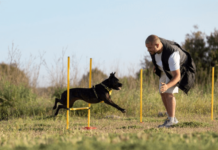Last Updated on January 16, 2023 by Dogs Vets
11 Simple Ways to Train Your Dog
Simple Ways to Train Your Dog: Training your dog can be a fun and rewarding experience for both you and your furry companion.
Not only will it strengthen your bond with your dog, but it will also ensure that they are well-behaved and can safely interact with others.
As a beginner, it can be overwhelming to know where to start, but don’t worry!
Here are 11 simple ways to train your dog as a beginner that will help you get started on the right foot.
- Start with basic commands: Teaching your dog basic commands like “sit,” “stay,” “come,” “heel,” and “lie down” is a great place to start. These commands are essential for everyday life and will set a foundation for more advanced training in the future.
- Use positive reinforcement: Positive reinforcement is a powerful training tool that rewards your dog for good behavior. Treats and praise are great rewards, but you can also use toys or playtime as a reward. The key is to make sure your dog associates the reward with the desired behavior.
- Be consistent: Consistency is key when training your dog. Use the same words and hand signals every time you give a command, and make sure everyone in your household is using the same commands. This will help your dog understand what you want them to do.
- Keep training sessions short: Dogs have a short attention span, so keep training sessions to around 15 minutes. This will help ensure that your dog stays focused and doesn’t get too tired or frustrated.
- Use a clicker: A clicker is a small, handheld device that makes a distinct “click” sound. When used correctly, it can be used to mark the exact moment your dog does something correctly, making it easier for them to understand what they did right.
- Practice in different environments: Training your dog in various locations will help them generalize commands and understand that they need to listen to you no matter where they are. This includes different rooms in your home, different parks or walking paths, or even different weather conditions.
- Socialize your dog: Socialization is an essential part of training your dog. Introduce your dog to different people, animals, and situations to help them become well-behaved in any situation. This will also help them to feel more confident and secure in new environments.
- Use a crate: Crate training can help with housebreaking and separation anxiety. A crate provides a safe and secure space for your dog, and can be a great tool for preventing bad behavior when you’re not around.
- Leash train your dog: Walking on a leash is an important skill for dogs to learn. Not only will it keep them safe, but it will also give you more control over their behavior when you’re out and about.
- Teach your dog to “speak” and “quiet”: Teaching your dog to bark on command and stop barking on command can be useful in certain situations. For example, if you want your dog to alert you to someone at the door, teaching them to “speak” on command can be helpful.
- Get professional help: If you’re having trouble training your dog, consider hiring a professional dog trainer for guidance. They can help you with specific problems and give you advice on how to train your dog effectively.
7 Questions and Answers
- How long should training sessions last?
Training sessions should last around 15 minutes. This will help ensure that your dog stays focused and doesn’t get too tired or frustrated.
- What is positive reinforcement?
Positive reinforcement is a powerful training tool that rewards your dog for good behavior. Treats and praise are great rewards, but you can also use toys or playtime as a reward. The key is to make sure your dog associates the reward with the desired behavior.
- How often should I train my dog?
It’s best to train your dog every day, even if it’s just for a few minutes. Consistency is key when it comes to training, and the more you work with your dog, the faster they will learn.
- How do I know if my dog is ready for more advanced training?
If your dog has mastered basic commands and is able to follow them consistently, they are ready for more advanced training. You can also tell if your dog is ready by observing their ability to focus and pay attention during training sessions.
- Can I use punishment to train my dog?
It’s not recommended to use punishment as a training method. Positive reinforcement is more effective and doesn’t cause any negative side effects such as fear or aggression.
- How can I teach my dog to stop barking excessively?
Teaching your dog to “quiet” on command can help with excessive barking. It’s also important to identify the reason for the barking, such as boredom or separation anxiety, and address those underlying issues.
- Is it necessary to hire a professional dog trainer?
It’s not necessary to hire a professional dog trainer, but it can be helpful if you’re having trouble training your dog or have specific problems you need help with. A professional trainer can also give you advice on how to train your dog effectively.
In conclusion, training your dog can be a fun and rewarding experience for both you and your furry companion.
By starting with basic commands, using positive reinforcement, being consistent, keeping training sessions short, using a clicker, practicing in different environments, socializing your dog, using a crate, leash training, teaching your dog to “speak” and “quiet” and getting professional help when needed, you’ll be well on your way to a well-trained dog.
Remember that every dog is different and may have different learning styles, so be patient and adapt your training methods to suit your dog’s needs.
Fact Check
We hope you enjoyed reading this article. What are your thoughts on the topic?
“At [Dogsvets.com], our goal is to bring you the most accurate and up-to-date information on all things pet-related.
If you have any additional insights or would like to advertise with us, don’t hesitate to get in touch.
If you notice any errors or discrepancies in our content, please let us know so we can correct them.
We welcome your feedback and encourage you to share this article with others.”

















